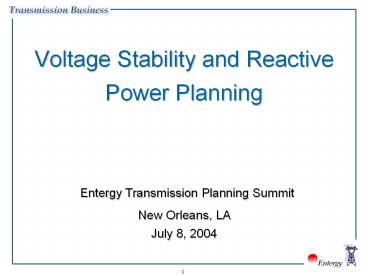Voltage Stability and Reactive Power Planning - PowerPoint PPT Presentation
Title:
Voltage Stability and Reactive Power Planning
Description:
Evaluate the effectiveness of existing reactive power and voltage control standards and how they are ... in the form of SVC/STATCOM to mitigate transient ... – PowerPoint PPT presentation
Number of Views:1766
Avg rating:3.0/5.0
Title: Voltage Stability and Reactive Power Planning
1
Voltage Stability and Reactive Power Planning
Entergy Transmission Planning Summit New
Orleans, LA July 8, 2004
2
Presentation Outline
- Reactive Power/Voltage Issues from the Northeast
Blackout - NERC Recommendations
- Background on Voltage Stability
- Reactive Power Requirements for Generators
- Voltage Stability Concerns in Entergy
- Summary
3
Voltage Profile During Aug 14th Blackout
- Voltages decay to almost 60 and initiates loss
of load - Slow recovery leads to generators tripping
- 60 voltage level also observed in 1995
Phoenix-area blackout
4
East Lake 5 Exciter Operation
Exciter trips to manual
Exciter trips completely
5
Power System Outage Task Force
- Strengthen Reactive Power and Control Practices
in all NERC Regions - Reactive power problem was a significant factor
in the August 14 outage, and they were also
important elements in the several of the earlier
outages - -Quote from the outage report
6
NERC Recommendations Pertinent to Reactive Power
Planning
- 7. Evaluate reactive power and voltage control
practices. - Evaluate the effectiveness of existing reactive
power and voltage control standards and how they
are being implemented in the NERC regions - Recommend revisions to standards or process
improvements to ensure voltage control and
stability issues are adequately addressed - 14. Improve system modeling data and data
exchange practices. - Establish and begin implementing criteria and
procedures for validating data used in power
flow/stability models by benchmarking model data
with actual system performance - Validated data shall be exchanged on an
inter-regional basis
7
What is Voltage Instability/Collapse?
- A power system undergoes voltage collapse if
post-disturbance voltages are below acceptable
limits - Less than 0.8 PU
- voltage collapse may be due to voltage or angular
instability - Main factor causing voltage instability is the
inability of the power systems to maintain a
proper balance of reactive power and voltage
control
8
Voltage Instability/Collapse
- The driving force for voltage instability is
usually the load. - The possible outcome of voltage instability
- loss of loads
- loss of integrity of the power system
- Voltage stability timeframe
- Short term/transient voltage instability 0 - 30
seconds - Motor dynamics/stalling
- OELs
- long-term voltage stability 1 60 minutes
- Tap changers/Voltage regulators
- OELs
9
Power-Voltage (P-V) Curve
10
Power Voltage (P-V) Curve
11
Possible Solutions forVoltage Issues
- Install/Operate Shunt Capacitor Banks
- Add dynamic Shunt Compensation in the form of
SVC/STATCOM to mitigate transient voltage dips - Add Series Compensation on transmission lines in
the problem area - Implement under-voltage load shed (UVLS) program
- Construct transmission/generation facilities
12
Generator Capability Curve
Over-excitation Limit
Lagging (Over-excited)
0.8 pf line
Stator Winding Heating Limit
- Per unit MVAR (Q)
Normal Excitation (Q 0, pF 1)
MW
Leading (Under-excited)
Under-excitation Limit
Stability Limit
13
Reactive Power Requirementsfor Generators
- The facility should generate reactive power in
accordance with the voltage schedule prescribed
by the system dispatcher. - Above 230 kV 1.02 PU
- 230 kV 1.01 PU
- 69 kV 161 kV 1.00 PU
- The facility shall have a reactive power
capability to maintain a power factor between
0.95 lagging and 0.97 leading. - Units must be operated with the voltage regulator
in auto mode. - Generator may be required to operate at its
maximum reactive capability to meet required
voltage schedules. - Ensure that adequate reactive reserves are
available so that the system can be restored
satisfactorily.
14
Areas of Voltage Stability Concern
North Arkansas
Mississippi
West of the Atchafalaya Basin (WOTAB)
Southeast Louisiana
Western Region
Amite South/DSG
15
Reactive Power Projects Implemented in Entergy
- Down Stream of Gypsy (DSG) Area
- 300 MVAR Shunt Capacitor Banks - 2004
- Automatic Under Voltage Load Shedding Program -
2004 - Static exciter at Ninemile 4 Unit - 2004
- 200 MVAR Shunt Capacitor Banks 2005
- 300 MVAR SVC at Ninemile 230 kV 2005
- Western Region
- Automatic Under Voltage Load Shedding Program
1998/modified 2004 - Series Compensation on China-Jacinto 230 KV line
2001 - 300 MVAR SVC at Porter 230 kV 2005
- Series Compensation on China Porter 230 kV line
- 2005
16
Summary
- The increasing need to operate the transmission
system at its maximum safe transfer limit has
become a primary concern at most utilities. - Reactive power supply or VAR management is an
important ingredient in maintaining healthy power
system voltages and facilitating power transfers. - Inadequate reactive power supply was a major
factor in most of the recent blackouts.
17
QUESTIONS ???































